Fracture Behavior of Steel Slag Powder-Cement-Based Concrete with Different Steel-Slag-Powder Replacement Ratios
Abstract
:1. Introduction
2. Experimental Design
2.1. Test Materials
2.2. Specimens and Mix Proportions
2.3. Experimental Setup
3. Results and Analysis
3.1. Fracture Mode
3.2. Fracture Energy
3.3. Fracture Toughness
3.4. Double K Fracture Model
4. Conclusions
- (1)
- The image-recognition method is used to analyze the fracture surface of the specimens, and the coarse-aggregate fracture ratio representing the ratios of fracture area of coarse aggregate to the total fracture area of the specimen is proposed to provide a quantitative-analysis method for the fracture-failure mode of the specimens. The results show that the coarse-aggregate fracture ratio R is consistent with the changing law of fracture-performance parameters under different steel-slag-powder replacement ratios which can imply the fracture mechanism.
- (2)
- Compared with concrete without steel-slag powder, a steel-slag-powder replacement ratio under 10% in weight can improve the fracture performance of the concrete, while a steel-slag-powder replacement ratio beyond 10% in weight shows a decreased effect, which implies positive and negative effects of steel-slag powder as a replacement to cement. The positive effect may be the filling effect of steel-slag powder, which strengthens the bond properties between the aggregate and matrix; and the negative effect may be the lower cementitious activity of steel slag compared with cement.
- (3)
- The fracture energy and fracture toughness of SPC first increases and then decreases with the increasing steel-slag-powder replacement ratio. The SPC with a 5% steel-slag-powder replacement ratio in weight shows the best fracture performance, while the fracture energy increases by 13.63%, fracture toughness increases by 53.22%, and compressive strength increases by 4.1% compared with NC, which may due to the addition of steel-slag powder strengthening the bond properties between the aggregate and matrix to a certain extent.
Author Contributions
Funding
Institutional Review Board Statement
Informed Consent Statement
Data Availability Statement
Acknowledgments
Conflicts of Interest
References
- Sha, F.; Liu, P.; Ding, Y. Application investigation of high-phosphorus steel slag in cementitious material and ordinary concrete. J. Mater. Res. Technol. 2021, 11, 2074–2091. [Google Scholar] [CrossRef]
- Xiong, Z.; Mai, G.; Qiao, S.; He, S.; Zhang, B.; Wang, H.; Zhou, K.; Li, L. Fatigue bond behaviour between basalt fibre-reinforced polymer bars and seawater sea-sand concrete. Ocean Coast. Manag. 2022, 218, 106038. [Google Scholar] [CrossRef]
- Lin, J.-X.; Song, Y.; Xie, Z.-H.; Guo, Y.-C.; Yuan, B.; Zeng, J.-J.; Wei, X. Static and dynamic mechanical behavior of engineered cementitious composites with PP and PVA fibers. J. Build. Eng. 2020, 29, 101097. [Google Scholar] [CrossRef]
- Xiong, Z.; Lin, L.; Qiao, S.; Li, L.; Li, Y.; He, S.; Li, Z.; Liu, F.; Chen, Y. Axial performance of seawater sea-sand concrete columns reinforced with basalt fibre-reinforced polymer bars under concentric compressive load. J. Build. Eng. 2022, 47, 103828. [Google Scholar] [CrossRef]
- Jiao, W.; Sha, A.; Liu, Z.; Jiang, W.; Hu, L.; Li, X. Utilization of steel slags to produce thermal conductive asphalt concretes for snow melting pavements. J. Clean. Prod. 2020, 261, 121197. [Google Scholar] [CrossRef]
- Guo, Y.C.; Xie, J.; Zheng, W.; Li, J. Effects of steel slag as fine aggregate on static and impact behaviours of concrete. Constr. Build. Mater. 2018, 192, 194–201. [Google Scholar] [CrossRef]
- Guo, J.; Bao, Y.; Wang, M. Steel slag in China: Treatment, recycling, and management. Waste Manag. 2018, 78, 318–330. [Google Scholar] [CrossRef]
- Humbert, P.S.; Castro-Gomes, J. CO2 activated steel slag-based materials: A review. J. Clean. Prod. 2019, 208, 448–457. [Google Scholar] [CrossRef]
- Liu, W.; Li, H.; Zhu, H.; Xu, P. Effects of Steel-Slag Components on Interfacial-Reaction Characteristics of Permeable Steel-Slag-Bitumen Mixture. Materials 2020, 13, 3885. [Google Scholar] [CrossRef]
- Parron-Rubio, M.E.; Perez-Garcia, F.; Gonzalez-Herrera, A.; Rubio-Cintas, M.D. Concrete Properties Comparison When Substituting a 25% Cement with Slag from Different Provenances. Materials 2018, 11, 1029. [Google Scholar] [CrossRef] [Green Version]
- Shen, W.; Liu, Y.; Wu, M.; Zhang, D.; Du, X.; Zhao, D.; Xu, G.; Zhang, B.; Xiong, X. Ecological carbonated steel slag pervious concrete prepared as a key material of sponge city. J. Clean. Prod. 2020, 256, 120244. [Google Scholar] [CrossRef]
- Roychand, R.; Kumar Pramanik, B.; Zhang, G.; Setunge, S. Recycling steel slag from municipal wastewater treatment plants into concrete applications—A step towards circular economy. Resour. Conserv. Recycl. 2020, 152, 104533. [Google Scholar] [CrossRef]
- Miah, M.J.; Patoary, M.M.H.; Paul, S.C.; Babafemi, A.J.; Panda, B. Enhancement of Mechanical Properties and Porosity of Concrete Using Steel Slag Coarse Aggregate. Materials 2020, 13, 2865. [Google Scholar] [CrossRef]
- Roslan, N.H.; Ismail, M.; Khalid, N.H.A.; Muhammad, B. Properties of concrete containing electric arc furnace steel slag and steel sludge. J. Build. Eng. 2020, 28, 101060. [Google Scholar] [CrossRef]
- Peng, Y.; Hu, S.; Ding, Q. Preparation of reactive powder concrete using fly ash and steel slag powder. J. Wuhan Univ. Technol.-Mater. Sci. Ed. 2010, 25, 349–354. [Google Scholar] [CrossRef]
- Roslan, N.H.; Ismail, M.; Abdul-Majid, Z.; Ghoreishiamiri, S.; Muhammad, B. Performance of steel slag and steel sludge in concrete. Constr. Build. Mater. 2016, 104, 16–24. [Google Scholar] [CrossRef]
- Maslehuddin, M.; Sharif, A.M.; Shameem, M.; Ibrahim, M.; Barry, M.S. Comparison of properties of steel slag and crushed limestone aggregate concretes. Constr. Build. Mater. 2003, 17, 105–112. [Google Scholar] [CrossRef]
- Saxena, S.; Tembhurkar, A.R. Impact of use of steel slag as coarse aggregate and wastewater on fresh and hardened properties of concrete. Constr. Build. Mater. 2018, 165, 126–137. [Google Scholar] [CrossRef]
- Abu-Eishah, S.I.; El-Dieb, A.S.; Bedir, M.S. Performance of concrete mixtures made with electric arc furnace (EAF) steel slag aggregate produced in the Arabian Gulf region. Constr. Build. Mater. 2012, 34, 249–256. [Google Scholar] [CrossRef]
- Khalaf, M.A.; Ban, C.C.; Ramli, M.; Ahmed, N.M.; Sern, L.J.; Khaleel, H.A. Physicomechanical and gamma-ray shielding properties of high-strength heavyweight concrete containing steel furnace slag aggregate. J. Build. Eng. 2020, 30, 101306. [Google Scholar] [CrossRef]
- Pellegrino, C.; Cavagnis, P.; Faleschini, F.; Brunelli, K. Properties of concretes with Black/Oxidizing Electric Arc Furnace slag aggregate. Cem. Concr. Compos. 2013, 37, 232–240. [Google Scholar] [CrossRef]
- Faleschini, F.; Zanini, M.A.; Toska, K. Seismic reliability assessment of code-conforming reinforced concrete buildings made with electric arc furnace slag aggregates. Eng. Struct. 2019, 195, 324–339. [Google Scholar] [CrossRef]
- Zanini, M.A. Structural reliability of bridges realized with reinforced concretes containing electric arc furnace slag aggregates. Eng. Struct. 2019, 188, 305–319. [Google Scholar] [CrossRef]
- Muhmood, L.; Vitta, S.; Venkateswaran, D. Cementitious and pozzolanic behavior of electric arc furnace steel slags. Cem. Concr. Res. 2009, 39, 102–109. [Google Scholar] [CrossRef]
- Papachristoforou, M.; Anastasiou, E.K.; Papayianni, I. Durability of steel fiber reinforced concrete with coarse steel slag aggregates including performance at elevated temperatures. Constr. Build. Mater. 2020, 262, 120569. [Google Scholar] [CrossRef]
- Guo, Y.; Xie, J.; Zhao, J.; Zuo, K. Utilization of unprocessed steel slag as fine aggregate in normal- and high-strength concrete. Constr. Build. Mater. 2019, 204, 41–49. [Google Scholar] [CrossRef]
- Palod, R.; Deo, S.V.; Ramtekkar, G.D. Effect on mechanical performance, early age shrinkage and electrical resistivity of ternary blended concrete containing blast furnace slag and steel slag. Mater. Today Proc. 2020, 32, 917–922. [Google Scholar] [CrossRef]
- Zhang, X.; Zhao, S.; Liu, Z.; Wang, F. Utilization of steel slag in ultra-high performance concrete with enhanced eco-friendliness. Constr. Build. Mater. 2019, 214, 28–36. [Google Scholar] [CrossRef]
- Santamaría, A.; Orbe, A.; San José, J.T.; González, J.J. A study on the durability of structural concrete incorporating electric steelmaking slags. Constr. Build. Mater. 2018, 161, 94–111. [Google Scholar] [CrossRef]
- Arribas, I.; Vegas, I.; San-José, J.T.; Manso, J.M. Durability studies on steelmaking slag concretes. Mater. Eng. 2014, 63, 168–176. [Google Scholar] [CrossRef]
- Kim, S.; Kim, Y.; Usman, M.; Park, C.; Hanif, A. Durability of slag waste incorporated steel fiber-reinforced concrete in marine environment. J. Build. Eng. 2021, 33, 101641. [Google Scholar] [CrossRef]
- Rooholamini, H.; Sedghi, R.; Ghobadipour, B.; Adresi, M. Effect of electric arc furnace steel slag on the mechanical and fracture properties of roller-compacted concrete. Constr. Build. Mater. 2019, 211, 88–98. [Google Scholar] [CrossRef]
- Peng, Y.Z.; Chen, K.; Hu, S.G. Durability and Microstructure of Ultra-High Performance Concrete Having High Volume of Steel Slag Powder and Ultra-Fine Fly Ash. Adv. Mater. Res. 2011, 255–260, 452–456. [Google Scholar]
- Qiang, W.; Mengxiao, S.; Jun, Y. Influence of classified steel slag with particle sizes smaller than 20 μm on the properties of cement and concrete. Constr. Build. Mater. 2016, 123, 601–610. [Google Scholar] [CrossRef]
- Yang, J.; Lu, J.; Wu, Q.; Xia, M.F.; Li, X. Influence of steel slag powders on the properties of MKPC paste. Constr. Build. Mater. 2018, 159, 137–146. [Google Scholar] [CrossRef]
- Fu, Q.; Ma, Q.; Zhu, Y. Experiment and Analysis on Compressive and Tensile Performance of Steel Slag Powder Concrete with Basalt Fiber. Sci. Technol. Eng. 2015, 35, 224–227. [Google Scholar]
- Zang, J. The Influence of Steel Slag with Variable Particle Size Distribution on the Workability and Mechanical Properties of Concrete. Ceram.-Silik. 2018, 63, 67–75. [Google Scholar] [CrossRef]
- Kaplan, M.F. Crack propagation and the fracture of concrete. J. ACI 1961, 11, 591–610. [Google Scholar]
- Hillerborg, A.; Modeer, M.; Peterson, P.E. Analysis of crack formation and crack growth in concrete by means of fracture. Cem. Concr. Res. 1976, 6, 773–782. [Google Scholar] [CrossRef]
- Guo, Y.C.; Zhang, J.H.; Chen, G.; Chen, G.M.; Xie, Z.H. Fracture behaviors of a new steel fiber reinforced recycled aggregate concrete with crumb rubber. Constr. Build. Mater. 2014, 53, 32–39. [Google Scholar] [CrossRef]
- Xie, Z.H.; Xie, J.H.; Huang, P.Y.; Guo, Y.C. Effects of High Temperature Damage on Compressive and Flexural Behavior of High Strength Recycled Aggregate Concrete with Steel Fiber and Crumb Rubber. China J. Highw. Transp. 2016, 29, 17–24. [Google Scholar]
- Hu, R.L.; Huang, P.Y.; Zhou, X.P. Determination of Double-K Fracture Toughness of Concrete via Size Effect Law. Sci. Technol. Eng. 2008, 8, 334–337. [Google Scholar]
- GB/T 50080-2016; Standard for Test Method of Performance on Ordinary Fresh Concrete. China Architecture & Building Press: Beijing, China, 2016; pp. 1–90.
- Rilem, T.C. Draft recommendation: “Determination of the fracture energy of mortar and concrete by means of three-point bend tests on notched beams”. Mater. Struct. 1985, 18, 484. [Google Scholar]
- Domenico, D.; Urso, S.; Borsellino, C.; Spinella, N.; Recupero, A. Bond behavior and ultimate capacity of notched concrete beams with externally-bonded FRP and PBO-FRCM systems under different environmental conditions. Constr. Build. Mater. 2020, 265, 121208. [Google Scholar] [CrossRef]
- Zhang, B.; Zhu, H.; Lu, F. Fracture properties of slag-based alkali-activated seawater coral aggregate concrete. Theor. Appl. Fract. Mech. 2021, 115, 103071. [Google Scholar] [CrossRef]
- Kitsutaka, Y.; Kanakubo, T. Outline of JCI standard (JCI-S-001-003). Concr. J. 2006, 44, 10–15. [Google Scholar] [CrossRef] [Green Version]
- Su-rong, L.; Hao, L. Experimental investigation on the fracture energy of fiber reinforced self-compacting concrete. Eng. Mech. 2010, 27, 119–123. [Google Scholar]
- Zhang, D.; Liu, J.L.; Chen, B. Analysis on determination of concrete fracture energy by three-point bending method. J. Build. Mater. 1999, 2, 206–211. [Google Scholar]
- Menou, A.; Mounajed, G.; Boussa, H.; Pineaud, A.; Carre, H. Residual fracture energy of cement paste, mortar and concrete subject to high temperature. Theor. Appl. Fract. Mech. 2006, 45, 64–71. [Google Scholar] [CrossRef]
- Pan, Z.; Zhou, J.; Jiang, X.; Xu, Y.; Jin, R.; Ma, J.; Zhuang, Y.; Diao, Z.; Zhang, S.; Si, Q.; et al. Investigating the effects of steel slag powder on the properties of self-compacting concrete with recycled aggregates. Constr. Build. Mater. 2019, 200, 570–577. [Google Scholar] [CrossRef]
- Chaudhuri, B.B.; Sarkar, N. Texture segmentation using fractal dimension. IEEE Trans. Pattern Anal. Mach. Intell. 1995, 17, 72–77. [Google Scholar] [CrossRef]
- Xu, S.; Xiong, S.; Li, H.; Yao, L. Quantitative characterization and mechanism analysis on thickness-dependent size effect of concrete fracture. China Civ. Eng. J. 2017, 50, 57–71. [Google Scholar]
- Zhuo, K.X. Experimental Study on Axial Compressive Properties of Environmental Steel Slag Concrete. Master’s Thesis, Guangdong University of Technology, Guangzhou, China, 2016. [Google Scholar]
- Hu, Y.Z.; Ge, Z. The effect of composite mineral admixtures containing steel slag on the properties of cementitious materials and concrete. Bull. Chin. Ceram. Soc. 2015, 34, 2737–2742. [Google Scholar]
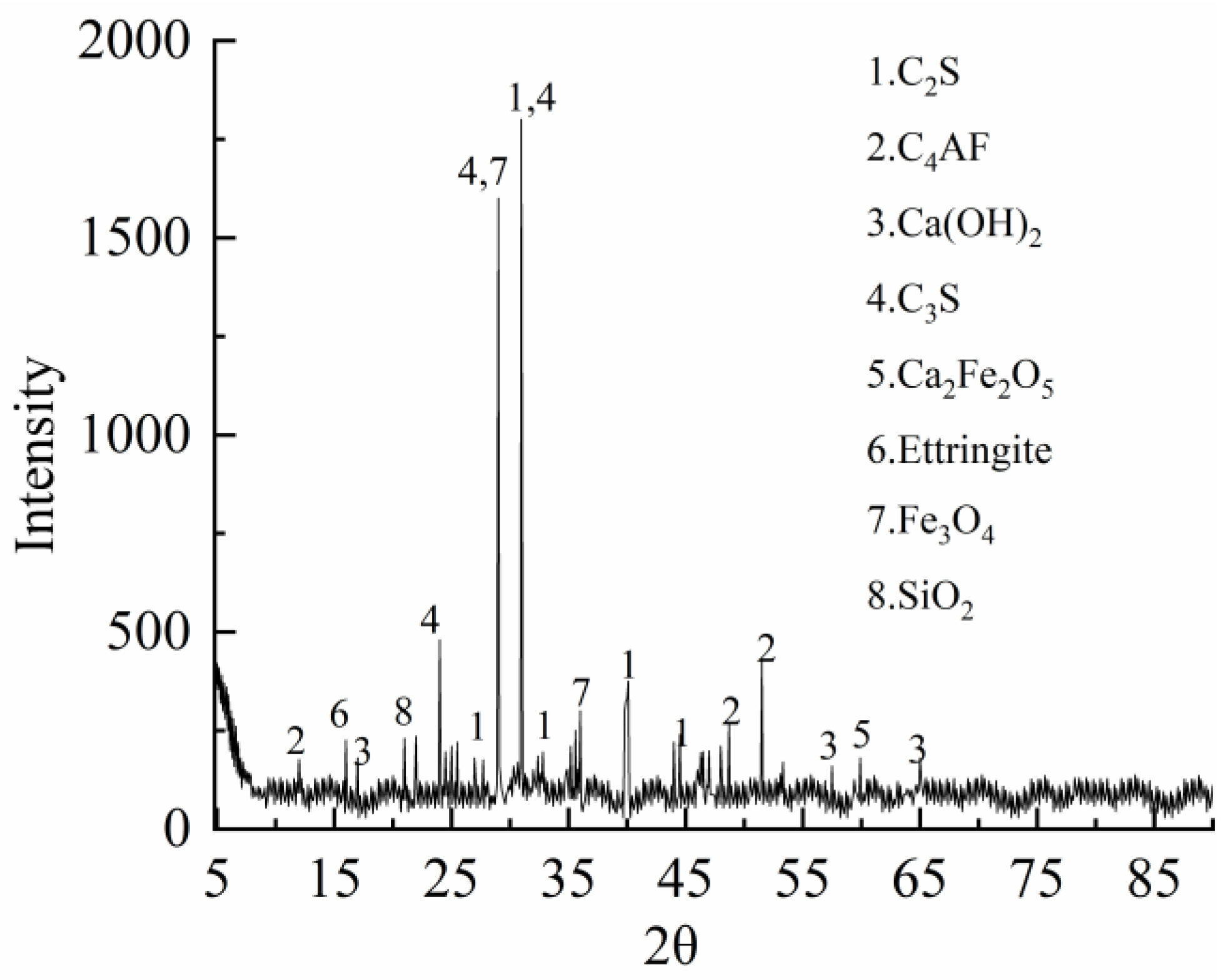
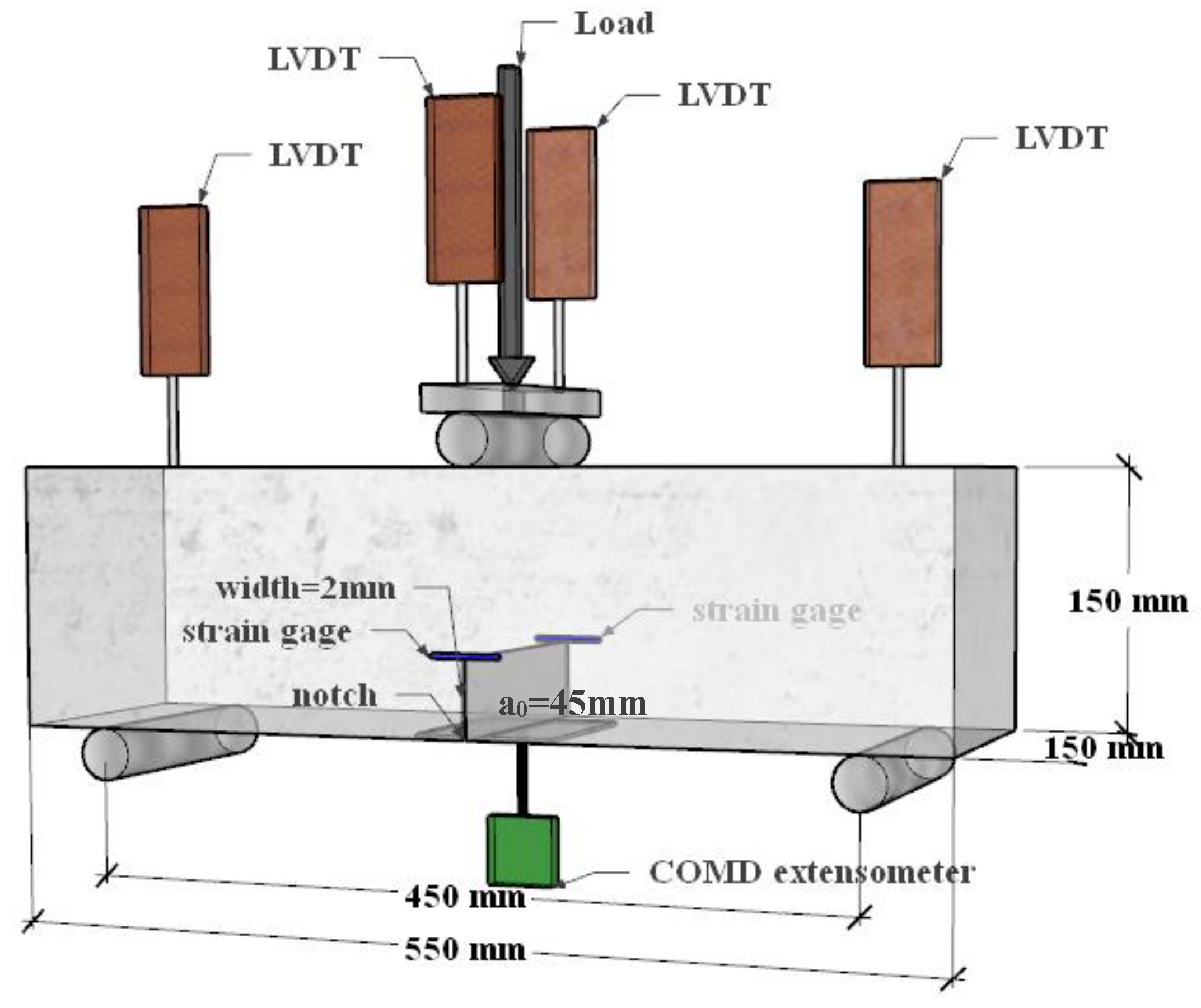


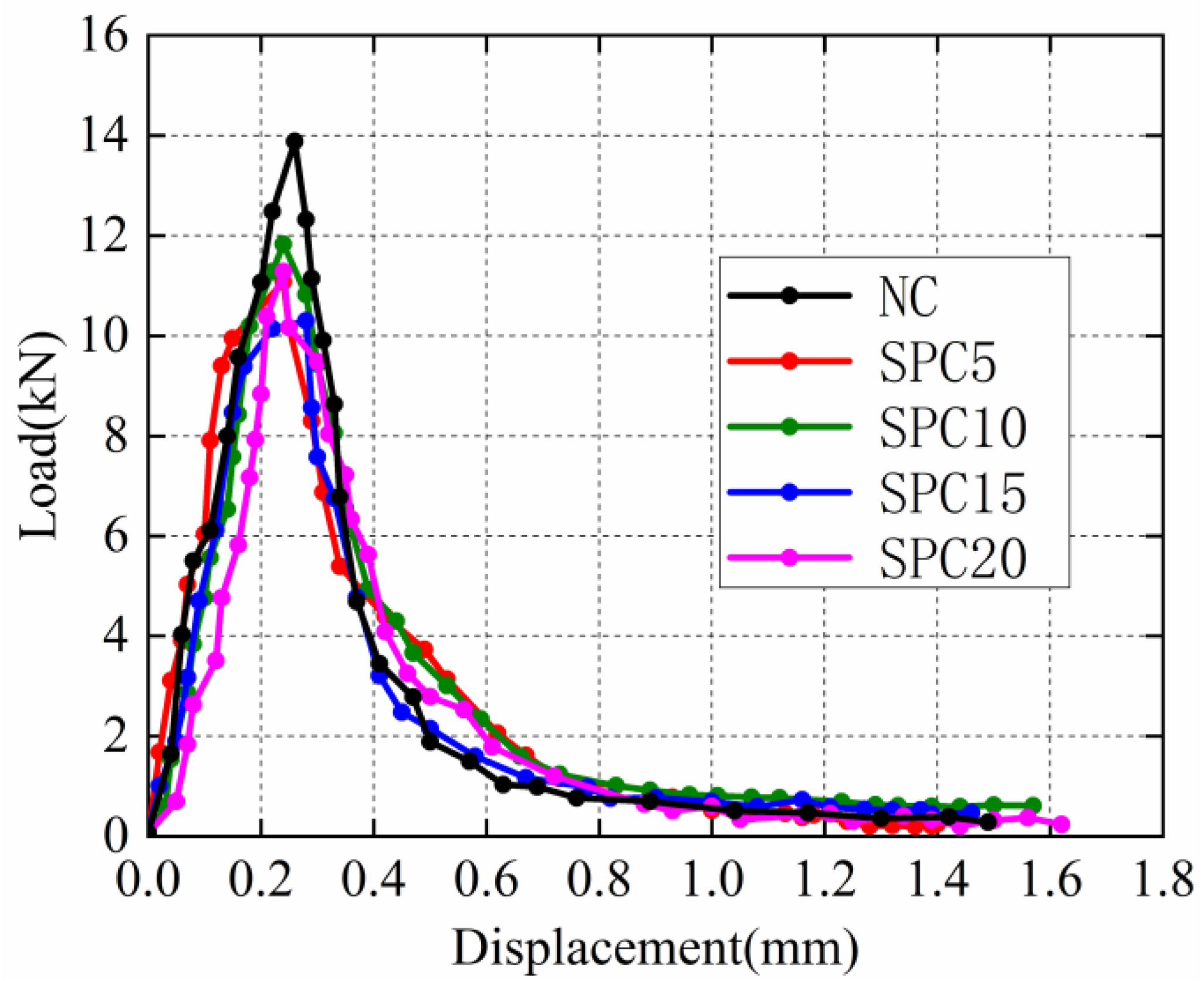

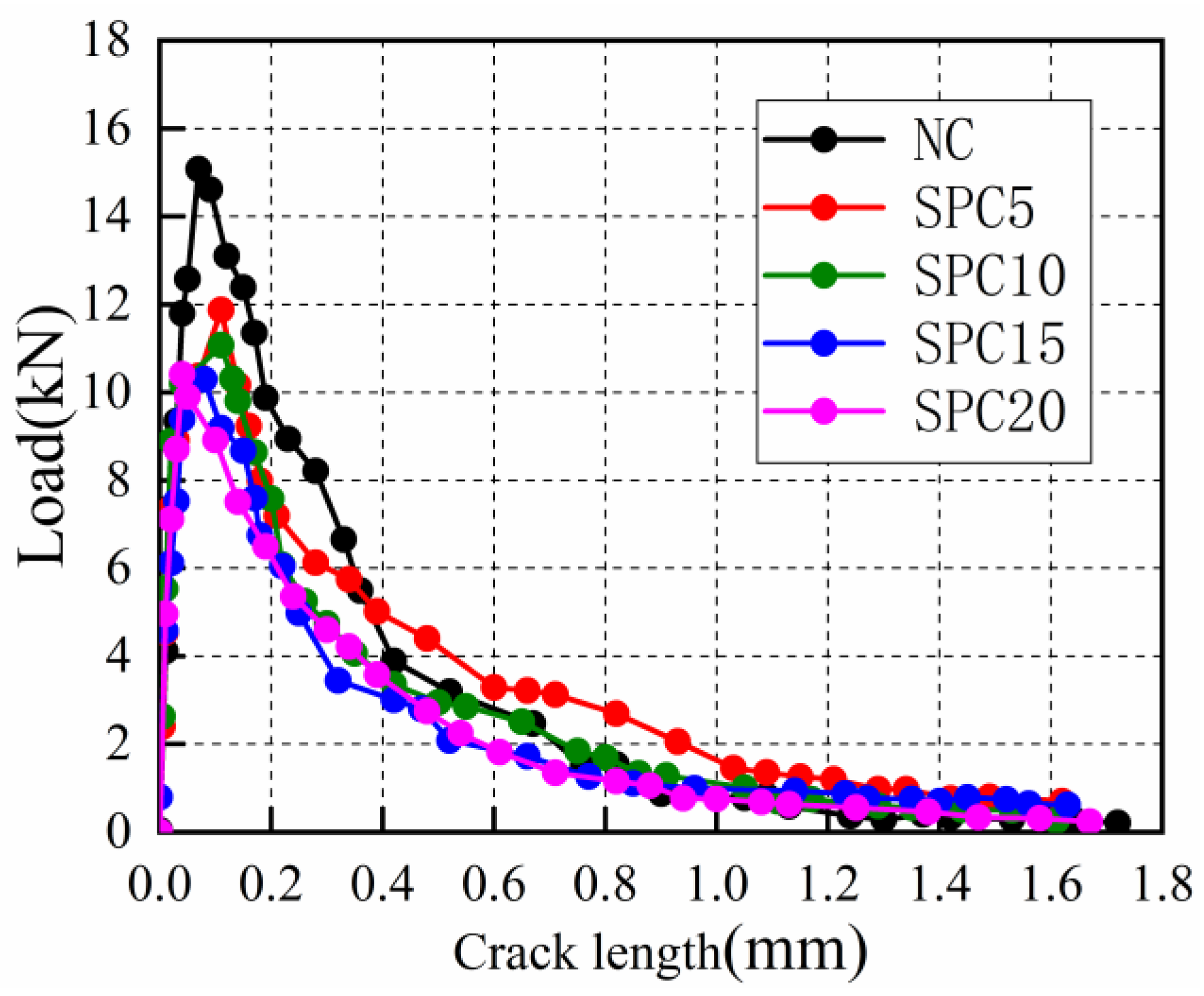
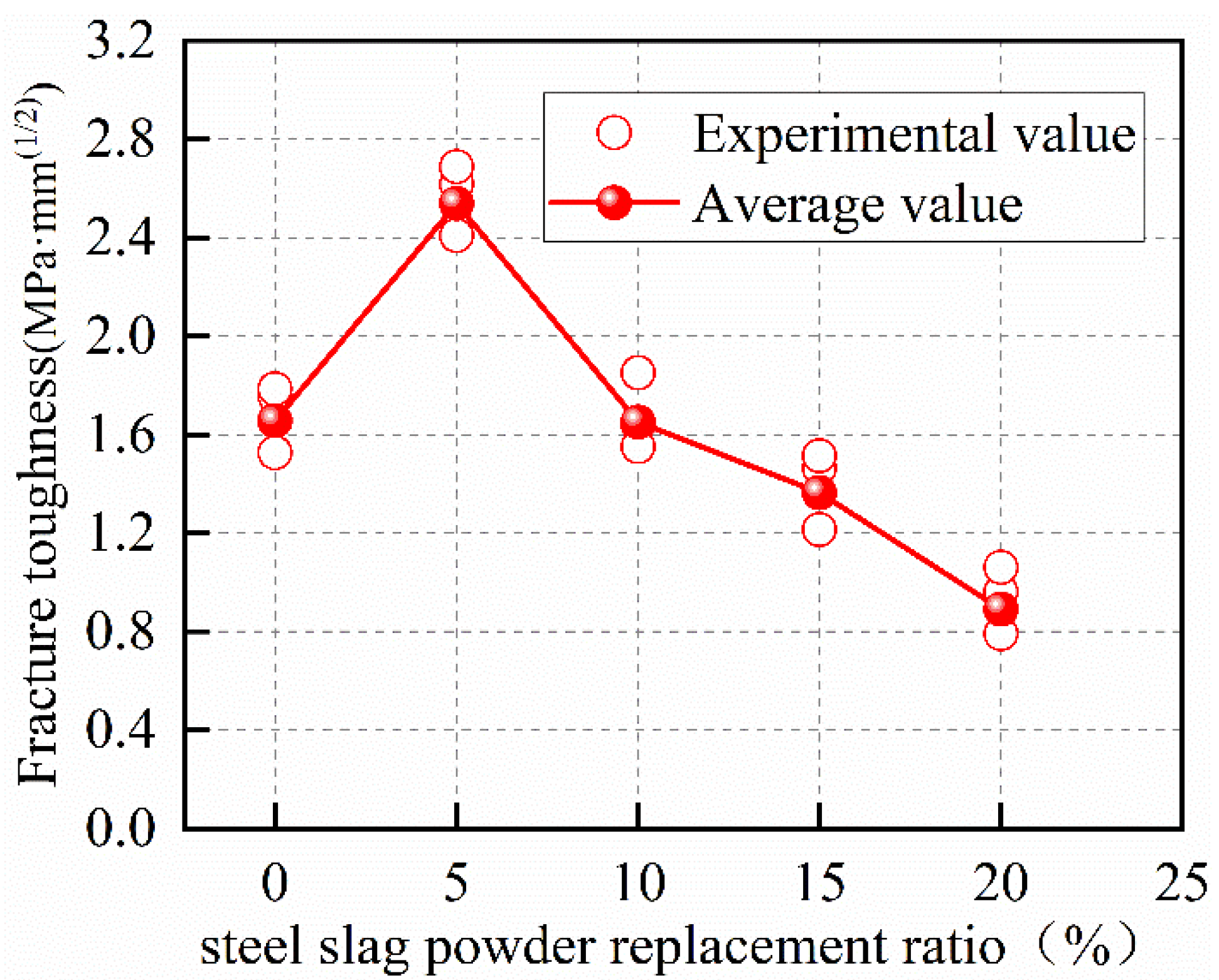
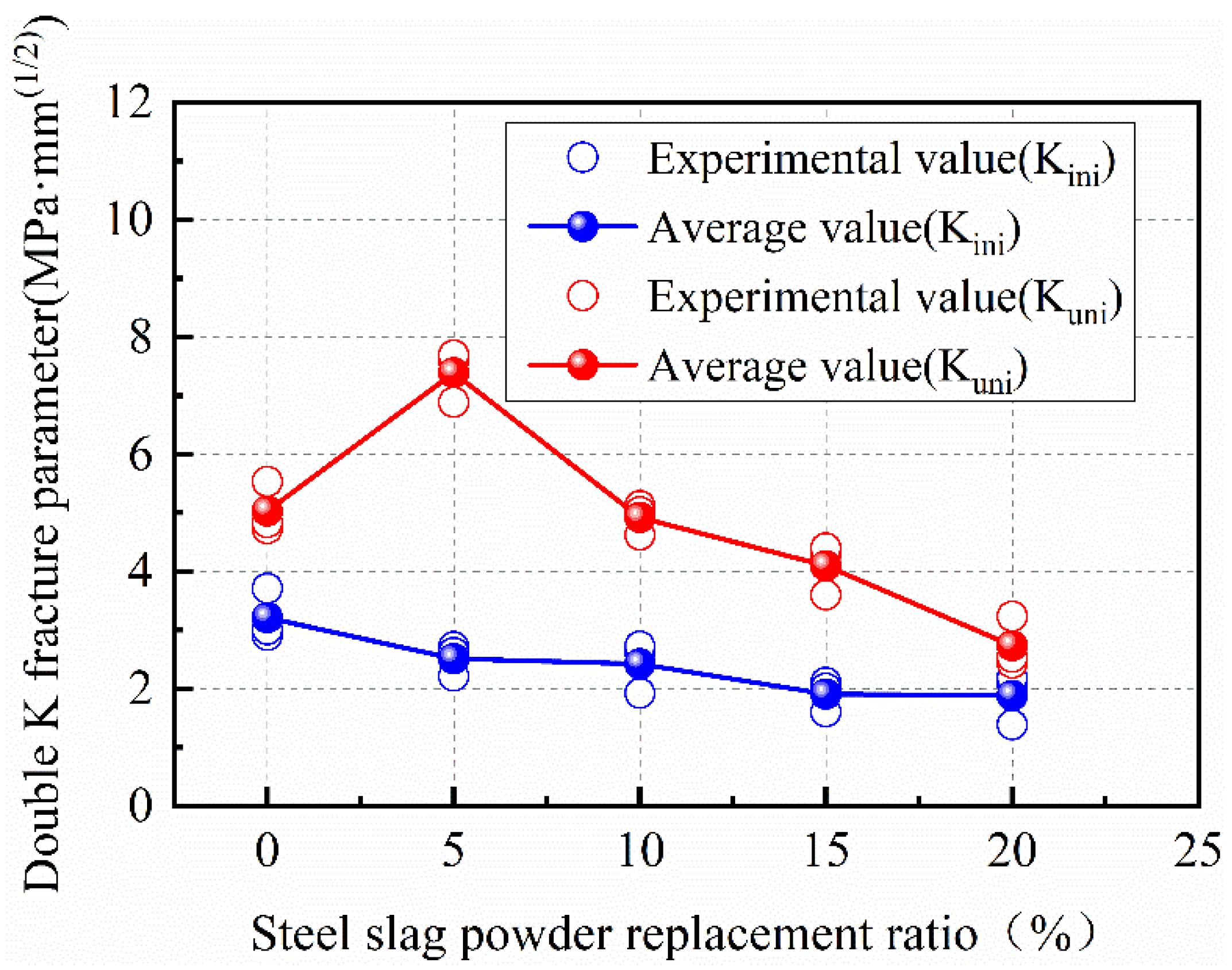
| Name | SiO2 | Al2O3 | Fe2O3 | CaO | MgO | SO3 | Na2O | K2O | R2O | Loss |
|---|---|---|---|---|---|---|---|---|---|---|
| Cement | 25.44 | 7.06 | 2.89 | 55.32 | 2.25 | 2.77 | 0.44 | 0.67 | 0.88 | 2.28 |
| Steel slag | 15.42 | 4.45 | 26.79 | 38.48 | 8.08 | 0.14 | 0.17 | 0.12 | 0.25 | 6.10 |
| Specimens | Water | Cement | River Sand | Coarse Aggregate | Steel-Slag Powder | Superplasticizer | Compressive Strength |
|---|---|---|---|---|---|---|---|
| NC | 168.8 | 287.7 | 530.3 | 990.3 | 0 | 1.42 | 34.17 |
| SPC5 | 168.8 | 273.3 | 530.3 | 990.3 | 14.4 | 1.42 | 35.57 |
| SPC10 | 168.8 | 258.9 | 530.3 | 990.3 | 28.7 | 1.42 | 32.47 |
| SPC15 | 168.8 | 244.6 | 530.3 | 990.3 | 43.1 | 1.42 | 29.25 |
| SPC20 | 168.8 | 230.2 | 530.3 | 990.3 | 57.5 | 1.42 | 28.82 |
| Specimens | a0 (mm) | Mg (N) | δ0 (mm) | β | λ | R2 | W0 (N·m) | W2 (N·m) | W3 (N·m) | Alig (m2) | Gf (J/m2) | Gf (Average) (J/m2) |
|---|---|---|---|---|---|---|---|---|---|---|---|---|
| N C-1 | 46.5 | 287.6 | 0.37 | 0.4 | 2.44 | 0.9830 | 4.236 | 0.532 | 1.163 | 0.01552 | 382.140 | 371.600 |
| N C-2 | 46.2 | 289.1 | 0.535 | 350.698 | ||||||||
| N C-3 | 46.8 | 286.1 | 0.529 | 381.961 | ||||||||
| SPC5-1 | 45.7 | 288.1 | 0.47 | 0.99 | 1.77 | 0.9695 | 4.17 | 0.677 | 2.299 | 0.01564 | 456.938 | 422.262 |
| SPC5-2 | 45.5 | 289.9 | 0.681 | 353.150 | ||||||||
| SPC5-3 | 45.4 | 286.5 | 0.673 | 456.698 | ||||||||
| SPC10-1 | 45.2 | 287.6 | 0.47 | 0.85 | 1.90 | 0.9653 | 4.125 | 0.676 | 1.863 | 0.01572 | 423.930 | 398.744 |
| SPC10-2 | 45.1 | 289.1 | 0.679 | 348.371 | ||||||||
| SPC10-3 | 44.8 | 287.6 | 0.676 | 423.930 | ||||||||
| SPC15-1 | 44.8 | 286.2 | 0.45 | 0.61 | 1.81 | 0.9878 | 3.662 | 0.644 | 1.438 | 0.01578 | 363.999 | 364.008 |
| SPC15-2 | 44.7 | 288.0 | 0.648 | 364.255 | ||||||||
| SPC15-3 | 44.4 | 284.6 | 0.640 | 363.770 | ||||||||
| SPC20-1 | 45 | 285.2 | 0.47 | 0.59 | 2.25 | 0.9819 | 3.587 | 0.670 | 1.213 | 0.01575 | 347.308 | 335.861 |
| SPC20-2 | 44.8 | 286.7 | 0.674 | 313.190 | ||||||||
| SPC20-3 | 44.7 | 283.7 | 0.667 | 347.084 |
| Specimens | a0 (mm) | ci (mm/KN) | h0 (mm) | mg (N) | Pmax (kN) | δ0 (mm) | CMODc (mm) | E (GPa) | Ac (mm) | KIC (MPa·mm(1/2)) | KIC (Average) (MPa·mm(1/2)) |
|---|---|---|---|---|---|---|---|---|---|---|---|
| N C-1 | 46.5 | 0.0033 | 1.45 | 287.6 | 15.08 | 0.26 | 0.07 | 26.86 | 61.90 | 1.663 | 1.66 |
| N C-2 | 46.2 | 0.0034 | 289.1 | 15.24 | 24.88 | 59.75 | 1.612 | ||||
| N C-3 | 46.8 | 0.0032 | 286.1 | 14.94 | 27.02 | 63.27 | 1.693 | ||||
| SPC5-1 | 45.7 | 0.0026 | 1.45 | 288.1 | 11.88 | 0.24 | 0.11 | 33.13 | 90.79 | 2.565 | 2.54 |
| SPC5-2 | 45.5 | 0.0027 | 289.9 | 12.04 | 30.55 | 88.81 | 2.465 | ||||
| SPC5-3 | 45.4 | 0.0025 | 286.5 | 11.74 | 32.88 | 91.47 | 2.582 | ||||
| SPC10-1 | 45.2 | 0.0031 | 1.45 | 287.6 | 11.08 | 0.24 | 0.08 | 27.29 | 77.55 | 1.711 | 1.65 |
| SPC10-2 | 45.1 | 0.0033 | 286.1 | 11.24 | 24.64 | 74.40 | 1.614 | ||||
| SPC10-3 | 44.8 | 0.0032 | 289.6 | 10.94 | 25.14 | 75.96 | 1.628 | ||||
| SPC15-1 | 44.8 | 0.0041 | 1.45 | 286.2 | 10.30 | 0.28 | 0.08 | 20.34 | 70.11 | 1.345 | 1.36 |
| SPC15-2 | 44.7 | 0.0038 | 287.7 | 10.21 | 21.09 | 72.40 | 1.402 | ||||
| SPC15-3 | 44.4 | 0.0040 | 284.7 | 10.38 | 19.82 | 69.73 | 1.345 | ||||
| SPC20-1 | 45.0 | 0.0038 | 1.45 | 285.2 | 10.41 | 0.24 | 0.04 | 22.11 | 48.73 | 0.898 | 0.89 |
| SPC20-2 | 44.8 | 0.0037 | 283.7 | 10.24 | 21.74 | 49.69 | 0.899 | ||||
| SPC20-3 | 44.7 | 0.0039 | 287.2 | 10.51 | 20.55 | 46.96 | 0.879 |
| Test Piece | a0 (mm) | Pini (kN) | Ac (mm) | Pmax (kN) | Kini (MPa·mm(1/2)) | Kuni (MPa·mm(1/2)) | Kini (Average) (MPa·mm(1/2)) | Kuni (Average) (MPa·mm(1/2)) |
|---|---|---|---|---|---|---|---|---|
| N C-1 | 46.5 | 12.67 | 61.9 | 15.08 | 3.229 | 5.056 | 3.21 | 5.04 |
| N C-2 | 46.2 | 12.87 | 59.8 | 15.24 | 3.263 | 4.910 | ||
| N C-3 | 46.8 | 12.27 | 63.3 | 14.94 | 3.143 | 5.139 | ||
| SPC5-1 | 45.7 | 10.04 | 85.9 | 11.88 | 2.524 | 6.601 | 2.64 | 6.58 |
| SPC5-2 | 45.5 | 11.03 | 84.8 | 12.04 | 2.764 | 6.523 | ||
| SPC5-3 | 45.4 | 10.56 | 86.4 | 11.74 | 2.641 | 6.611 | ||
| SPC10-1 | 45.2 | 9.76 | 77.5 | 11.08 | 2.433 | 5.088 | 2.43 | 4.92 |
| SPC10-2 | 45.1 | 9.46 | 74.4 | 11.24 | 2.354 | 4.825 | ||
| SPC10-3 | 44.8 | 10.06 | 76.0 | 10.94 | 2.491 | 4.855 | ||
| SPC15-1 | 44.8 | 7.80 | 70.1 | 10.30 | 1.931 | 4.049 | 1.91 | 4.10 |
| SPC15-2 | 44.7 | 8.00 | 72.4 | 10.21 | 1.977 | 4.205 | ||
| SPC15-3 | 44.4 | 7.40 | 69.7 | 10.38 | 1.820 | 4.049 | ||
| SPC20-1 | 45.0 | 7.62 | 48.7 | 10.41 | 1.893 | 2.757 | 1.89 | 2.74 |
| SPC20-2 | 44.8 | 7.32 | 49.7 | 10.24 | 1.812 | 2.757 | ||
| SPC20-3 | 44.7 | 7.92 | 47.0 | 10.51 | 1.957 | 2.700 |
Publisher’s Note: MDPI stays neutral with regard to jurisdictional claims in published maps and institutional affiliations. |
© 2022 by the authors. Licensee MDPI, Basel, Switzerland. This article is an open access article distributed under the terms and conditions of the Creative Commons Attribution (CC BY) license (https://creativecommons.org/licenses/by/4.0/).
Share and Cite
Zhuo, K.-X.; Liu, G.-T.; Lan, X.-W.; Zheng, D.-P.; Wu, S.-Q.; Wu, P.-Z.; Guo, Y.-C.; Lin, J.-X. Fracture Behavior of Steel Slag Powder-Cement-Based Concrete with Different Steel-Slag-Powder Replacement Ratios. Materials 2022, 15, 2243. https://doi.org/10.3390/ma15062243
Zhuo K-X, Liu G-T, Lan X-W, Zheng D-P, Wu S-Q, Wu P-Z, Guo Y-C, Lin J-X. Fracture Behavior of Steel Slag Powder-Cement-Based Concrete with Different Steel-Slag-Powder Replacement Ratios. Materials. 2022; 15(6):2243. https://doi.org/10.3390/ma15062243
Chicago/Turabian StyleZhuo, Ke-Xian, Guo-Tao Liu, Xue-Wei Lan, Dong-Ping Zheng, Si-Quan Wu, Pei-Zong Wu, Yong-Chang Guo, and Jia-Xiang Lin. 2022. "Fracture Behavior of Steel Slag Powder-Cement-Based Concrete with Different Steel-Slag-Powder Replacement Ratios" Materials 15, no. 6: 2243. https://doi.org/10.3390/ma15062243
APA StyleZhuo, K.-X., Liu, G.-T., Lan, X.-W., Zheng, D.-P., Wu, S.-Q., Wu, P.-Z., Guo, Y.-C., & Lin, J.-X. (2022). Fracture Behavior of Steel Slag Powder-Cement-Based Concrete with Different Steel-Slag-Powder Replacement Ratios. Materials, 15(6), 2243. https://doi.org/10.3390/ma15062243







